The Great Wall (China) UNESCO Cultural World Heritage
VerifiedAdded on 2023/04/23
|9
|1718
|484
AI Summary
This report explores the tourism and cultural aspects of The Great Wall (China), including management, problems faced, recommendations, and sustainable development strategies. The Great Wall (China) is a UNESCO Cultural World Heritage site that attracts visitors from around the world.
Contribute Materials
Your contribution can guide someone’s learning journey. Share your
documents today.
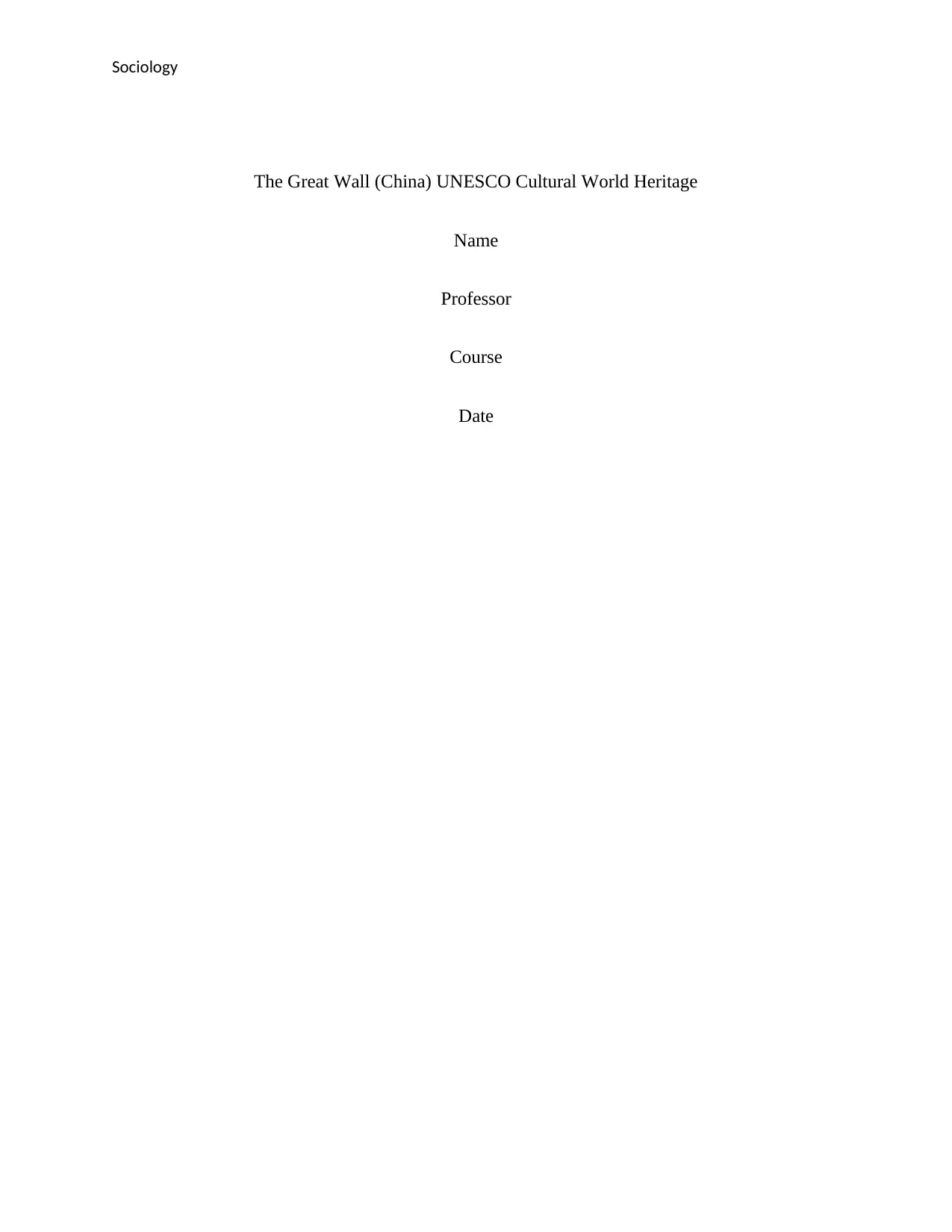
Sociology
The Great Wall (China) UNESCO Cultural World Heritage
Name
Professor
Course
Date
The Great Wall (China) UNESCO Cultural World Heritage
Name
Professor
Course
Date
Secure Best Marks with AI Grader
Need help grading? Try our AI Grader for instant feedback on your assignments.
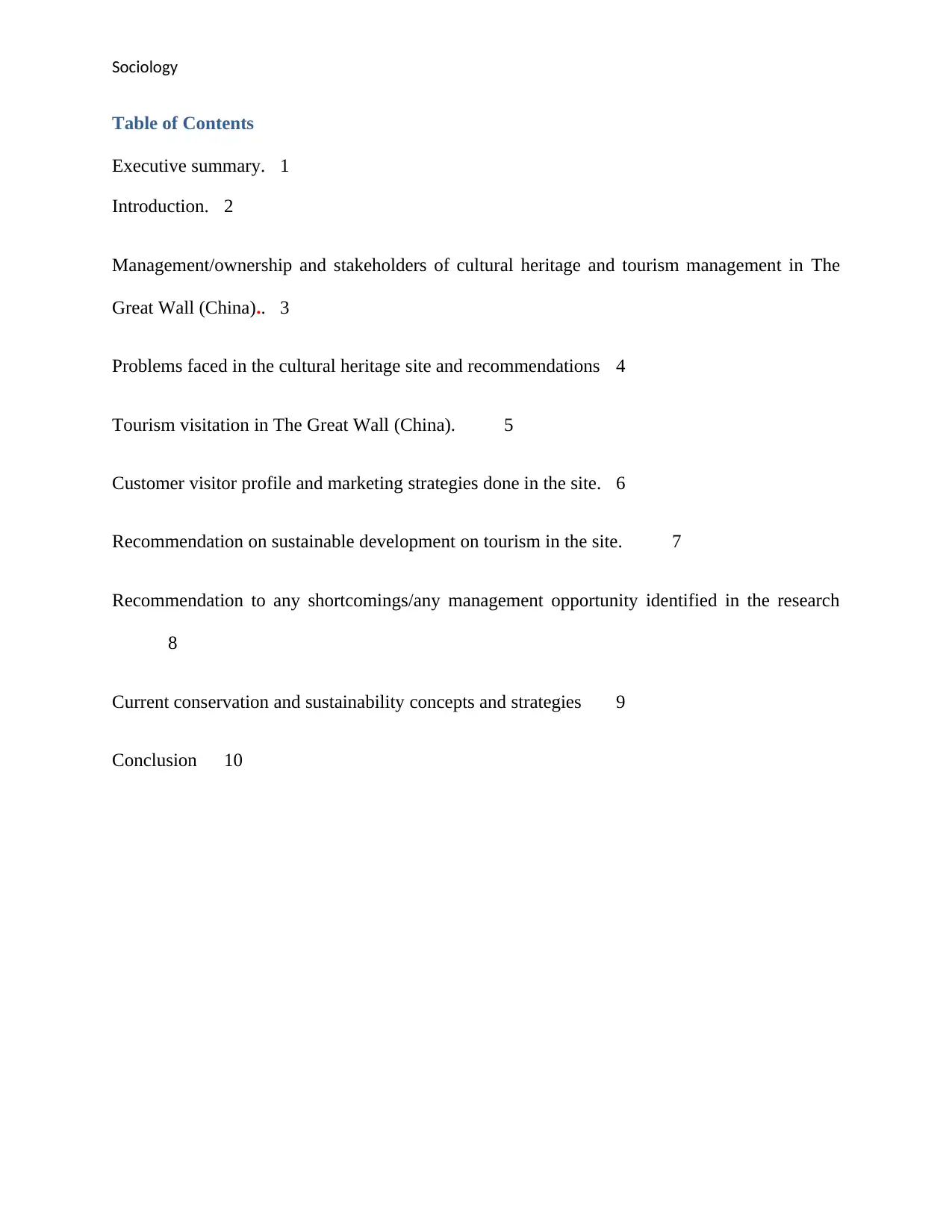
Sociology
Table of Contents
Executive summary. 1
Introduction. 2
Management/ownership and stakeholders of cultural heritage and tourism management in The
Great Wall (China).. 3
Problems faced in the cultural heritage site and recommendations 4
Tourism visitation in The Great Wall (China). 5
Customer visitor profile and marketing strategies done in the site. 6
Recommendation on sustainable development on tourism in the site. 7
Recommendation to any shortcomings/any management opportunity identified in the research
8
Current conservation and sustainability concepts and strategies 9
Conclusion 10
Table of Contents
Executive summary. 1
Introduction. 2
Management/ownership and stakeholders of cultural heritage and tourism management in The
Great Wall (China).. 3
Problems faced in the cultural heritage site and recommendations 4
Tourism visitation in The Great Wall (China). 5
Customer visitor profile and marketing strategies done in the site. 6
Recommendation on sustainable development on tourism in the site. 7
Recommendation to any shortcomings/any management opportunity identified in the research
8
Current conservation and sustainability concepts and strategies 9
Conclusion 10
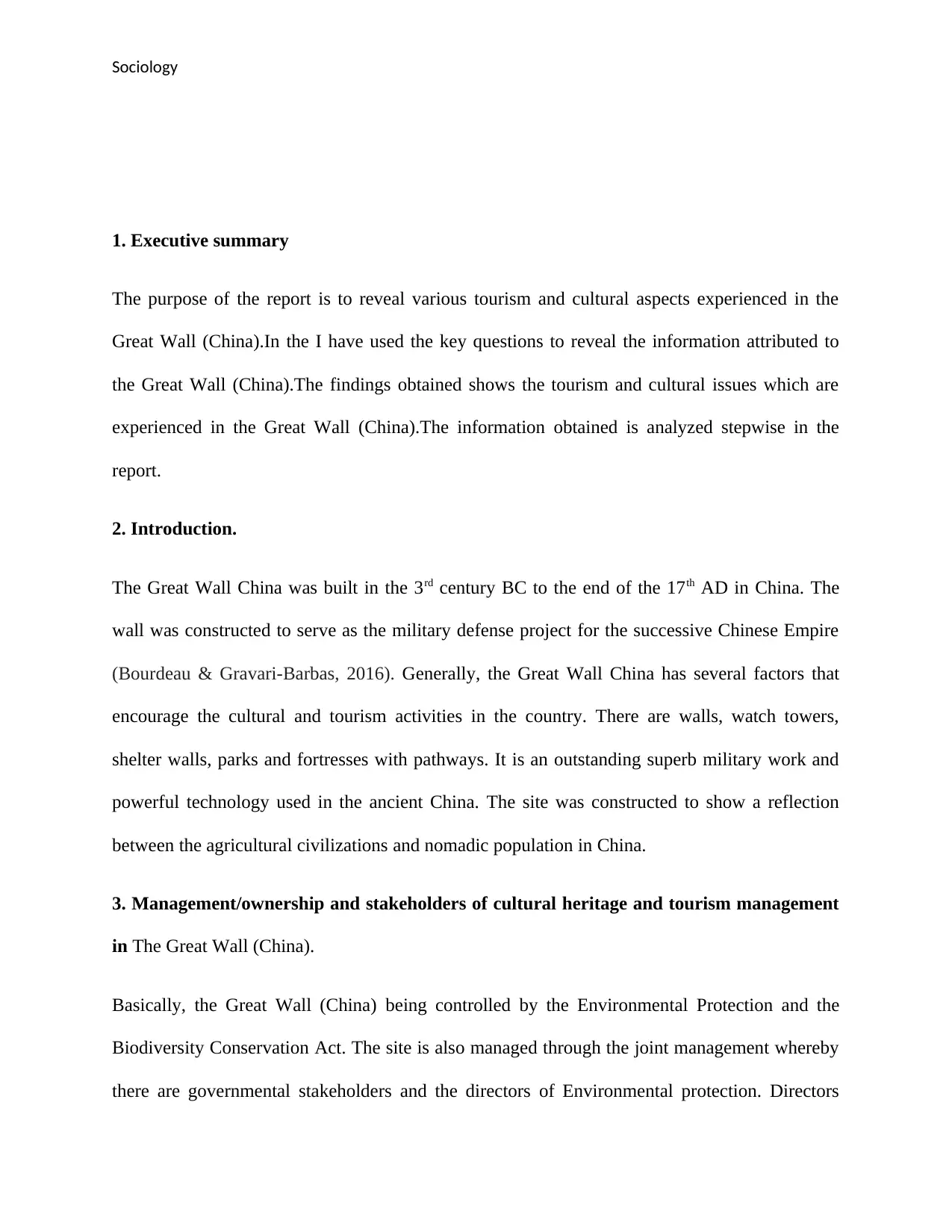
Sociology
1. Executive summary
The purpose of the report is to reveal various tourism and cultural aspects experienced in the
Great Wall (China).In the I have used the key questions to reveal the information attributed to
the Great Wall (China).The findings obtained shows the tourism and cultural issues which are
experienced in the Great Wall (China).The information obtained is analyzed stepwise in the
report.
2. Introduction.
The Great Wall China was built in the 3rd century BC to the end of the 17th AD in China. The
wall was constructed to serve as the military defense project for the successive Chinese Empire
(Bourdeau & Gravari-Barbas, 2016). Generally, the Great Wall China has several factors that
encourage the cultural and tourism activities in the country. There are walls, watch towers,
shelter walls, parks and fortresses with pathways. It is an outstanding superb military work and
powerful technology used in the ancient China. The site was constructed to show a reflection
between the agricultural civilizations and nomadic population in China.
3. Management/ownership and stakeholders of cultural heritage and tourism management
in The Great Wall (China).
Basically, the Great Wall (China) being controlled by the Environmental Protection and the
Biodiversity Conservation Act. The site is also managed through the joint management whereby
there are governmental stakeholders and the directors of Environmental protection. Directors
1. Executive summary
The purpose of the report is to reveal various tourism and cultural aspects experienced in the
Great Wall (China).In the I have used the key questions to reveal the information attributed to
the Great Wall (China).The findings obtained shows the tourism and cultural issues which are
experienced in the Great Wall (China).The information obtained is analyzed stepwise in the
report.
2. Introduction.
The Great Wall China was built in the 3rd century BC to the end of the 17th AD in China. The
wall was constructed to serve as the military defense project for the successive Chinese Empire
(Bourdeau & Gravari-Barbas, 2016). Generally, the Great Wall China has several factors that
encourage the cultural and tourism activities in the country. There are walls, watch towers,
shelter walls, parks and fortresses with pathways. It is an outstanding superb military work and
powerful technology used in the ancient China. The site was constructed to show a reflection
between the agricultural civilizations and nomadic population in China.
3. Management/ownership and stakeholders of cultural heritage and tourism management
in The Great Wall (China).
Basically, the Great Wall (China) being controlled by the Environmental Protection and the
Biodiversity Conservation Act. The site is also managed through the joint management whereby
there are governmental stakeholders and the directors of Environmental protection. Directors

Sociology
manage the tourism activities and cultural aspects exchanged around the Great Wall (China)
(Margottini, 2013).The entire cultural title is owned by the population around the wall which is
managed by the China Culture Trust Act. The surrounding people have leased the land through
the Director of National Environment Protection thus helping the population to incur huge
benefits from international visitors in the country.
4. Problems faced in the cultural heritage site and recommendations
Limited access to cultural heritage products, promotion and marketing strategies. The Great Wall
(China) lacks marketing skills to promote some of its cultural activities thus unable to target
large number of visitors.
Increased competition from other tourist sites. There are number of cultural heritage sites
surrounding the wall thus attracting small number of visitors. Also, the cultural tourism and other
tourism activities are incurring competition in international world.
There is little training on how to conserve the available culture .The people around the wall are
unable to identify the issue of cultural tourism (Silverman & Blumenfield, 2013). There no
structured price used by the people around the wall when selling their products to visitors.
Also, there is risk on deterioration of cultural aspects such as monuments and other products in
the park.
Recommendations on the challenges experienced in the wall.
There is need to ensure there is awareness on cultural conservation in the wall. The country
needs to come up with national awareness on how protect the cultural products and other
destinations around the wall.
manage the tourism activities and cultural aspects exchanged around the Great Wall (China)
(Margottini, 2013).The entire cultural title is owned by the population around the wall which is
managed by the China Culture Trust Act. The surrounding people have leased the land through
the Director of National Environment Protection thus helping the population to incur huge
benefits from international visitors in the country.
4. Problems faced in the cultural heritage site and recommendations
Limited access to cultural heritage products, promotion and marketing strategies. The Great Wall
(China) lacks marketing skills to promote some of its cultural activities thus unable to target
large number of visitors.
Increased competition from other tourist sites. There are number of cultural heritage sites
surrounding the wall thus attracting small number of visitors. Also, the cultural tourism and other
tourism activities are incurring competition in international world.
There is little training on how to conserve the available culture .The people around the wall are
unable to identify the issue of cultural tourism (Silverman & Blumenfield, 2013). There no
structured price used by the people around the wall when selling their products to visitors.
Also, there is risk on deterioration of cultural aspects such as monuments and other products in
the park.
Recommendations on the challenges experienced in the wall.
There is need to ensure there is awareness on cultural conservation in the wall. The country
needs to come up with national awareness on how protect the cultural products and other
destinations around the wall.
Secure Best Marks with AI Grader
Need help grading? Try our AI Grader for instant feedback on your assignments.
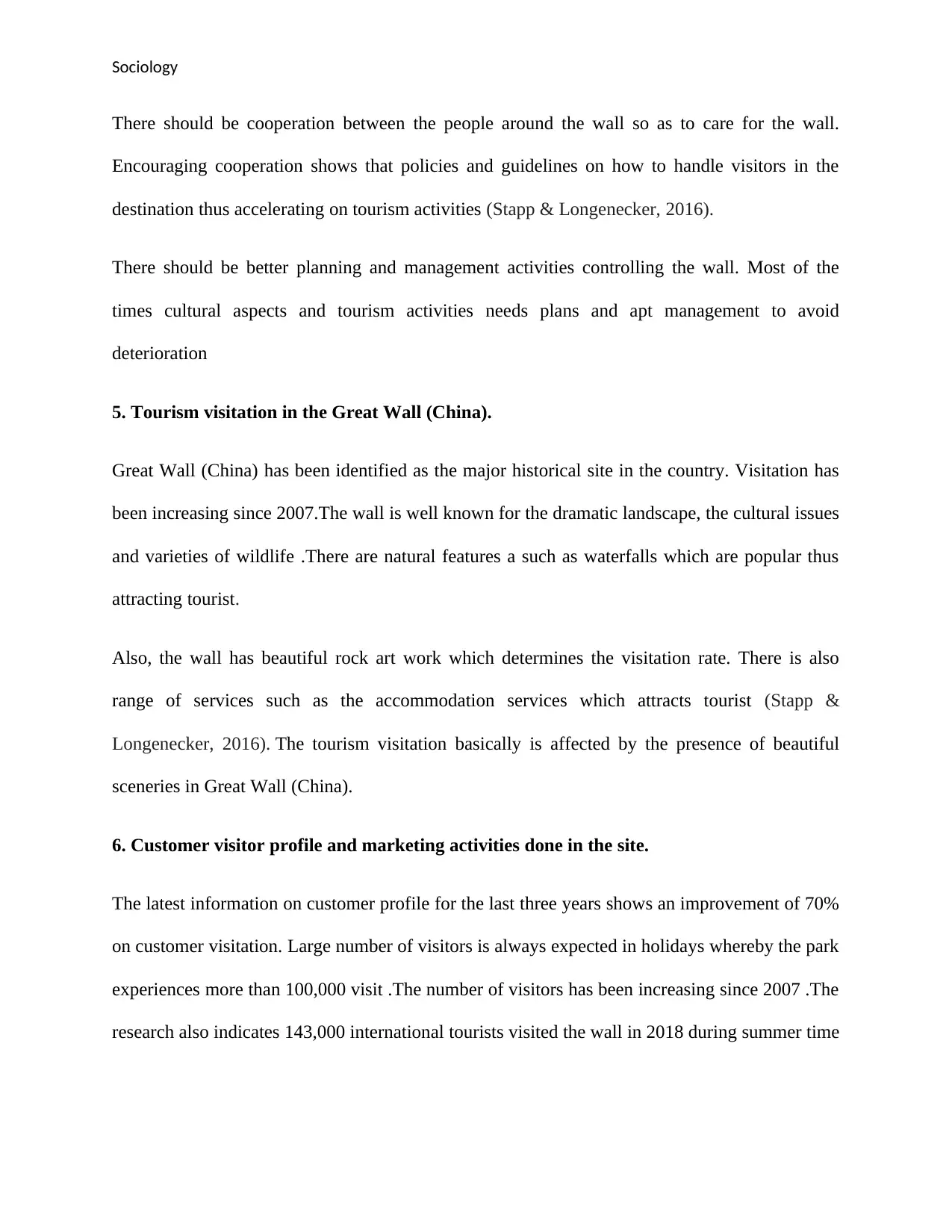
Sociology
There should be cooperation between the people around the wall so as to care for the wall.
Encouraging cooperation shows that policies and guidelines on how to handle visitors in the
destination thus accelerating on tourism activities (Stapp & Longenecker, 2016).
There should be better planning and management activities controlling the wall. Most of the
times cultural aspects and tourism activities needs plans and apt management to avoid
deterioration
5. Tourism visitation in the Great Wall (China).
Great Wall (China) has been identified as the major historical site in the country. Visitation has
been increasing since 2007.The wall is well known for the dramatic landscape, the cultural issues
and varieties of wildlife .There are natural features a such as waterfalls which are popular thus
attracting tourist.
Also, the wall has beautiful rock art work which determines the visitation rate. There is also
range of services such as the accommodation services which attracts tourist (Stapp &
Longenecker, 2016). The tourism visitation basically is affected by the presence of beautiful
sceneries in Great Wall (China).
6. Customer visitor profile and marketing activities done in the site.
The latest information on customer profile for the last three years shows an improvement of 70%
on customer visitation. Large number of visitors is always expected in holidays whereby the park
experiences more than 100,000 visit .The number of visitors has been increasing since 2007 .The
research also indicates 143,000 international tourists visited the wall in 2018 during summer time
There should be cooperation between the people around the wall so as to care for the wall.
Encouraging cooperation shows that policies and guidelines on how to handle visitors in the
destination thus accelerating on tourism activities (Stapp & Longenecker, 2016).
There should be better planning and management activities controlling the wall. Most of the
times cultural aspects and tourism activities needs plans and apt management to avoid
deterioration
5. Tourism visitation in the Great Wall (China).
Great Wall (China) has been identified as the major historical site in the country. Visitation has
been increasing since 2007.The wall is well known for the dramatic landscape, the cultural issues
and varieties of wildlife .There are natural features a such as waterfalls which are popular thus
attracting tourist.
Also, the wall has beautiful rock art work which determines the visitation rate. There is also
range of services such as the accommodation services which attracts tourist (Stapp &
Longenecker, 2016). The tourism visitation basically is affected by the presence of beautiful
sceneries in Great Wall (China).
6. Customer visitor profile and marketing activities done in the site.
The latest information on customer profile for the last three years shows an improvement of 70%
on customer visitation. Large number of visitors is always expected in holidays whereby the park
experiences more than 100,000 visit .The number of visitors has been increasing since 2007 .The
research also indicates 143,000 international tourists visited the wall in 2018 during summer time
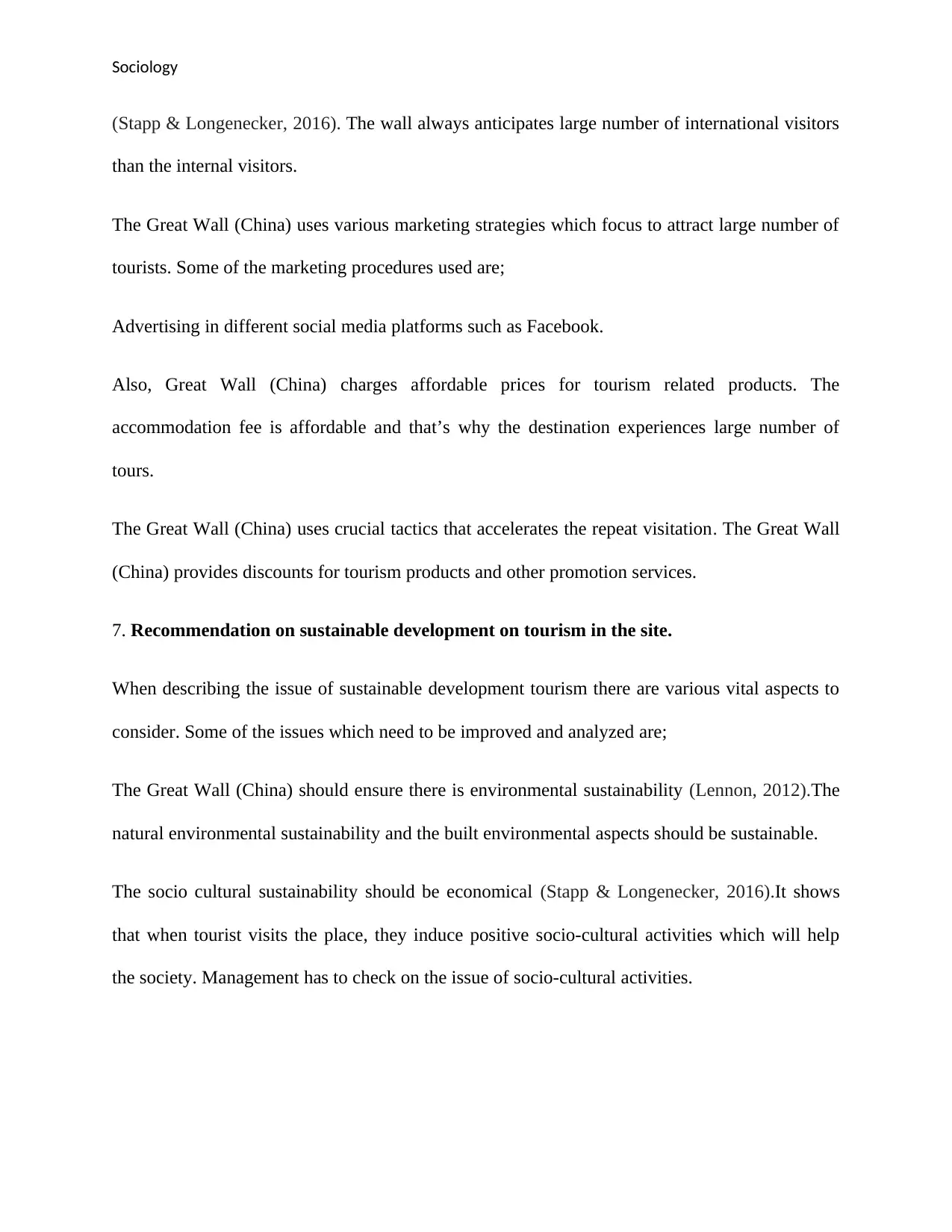
Sociology
(Stapp & Longenecker, 2016). The wall always anticipates large number of international visitors
than the internal visitors.
The Great Wall (China) uses various marketing strategies which focus to attract large number of
tourists. Some of the marketing procedures used are;
Advertising in different social media platforms such as Facebook.
Also, Great Wall (China) charges affordable prices for tourism related products. The
accommodation fee is affordable and that’s why the destination experiences large number of
tours.
The Great Wall (China) uses crucial tactics that accelerates the repeat visitation. The Great Wall
(China) provides discounts for tourism products and other promotion services.
7. Recommendation on sustainable development on tourism in the site.
When describing the issue of sustainable development tourism there are various vital aspects to
consider. Some of the issues which need to be improved and analyzed are;
The Great Wall (China) should ensure there is environmental sustainability (Lennon, 2012).The
natural environmental sustainability and the built environmental aspects should be sustainable.
The socio cultural sustainability should be economical (Stapp & Longenecker, 2016).It shows
that when tourist visits the place, they induce positive socio-cultural activities which will help
the society. Management has to check on the issue of socio-cultural activities.
(Stapp & Longenecker, 2016). The wall always anticipates large number of international visitors
than the internal visitors.
The Great Wall (China) uses various marketing strategies which focus to attract large number of
tourists. Some of the marketing procedures used are;
Advertising in different social media platforms such as Facebook.
Also, Great Wall (China) charges affordable prices for tourism related products. The
accommodation fee is affordable and that’s why the destination experiences large number of
tours.
The Great Wall (China) uses crucial tactics that accelerates the repeat visitation. The Great Wall
(China) provides discounts for tourism products and other promotion services.
7. Recommendation on sustainable development on tourism in the site.
When describing the issue of sustainable development tourism there are various vital aspects to
consider. Some of the issues which need to be improved and analyzed are;
The Great Wall (China) should ensure there is environmental sustainability (Lennon, 2012).The
natural environmental sustainability and the built environmental aspects should be sustainable.
The socio cultural sustainability should be economical (Stapp & Longenecker, 2016).It shows
that when tourist visits the place, they induce positive socio-cultural activities which will help
the society. Management has to check on the issue of socio-cultural activities.
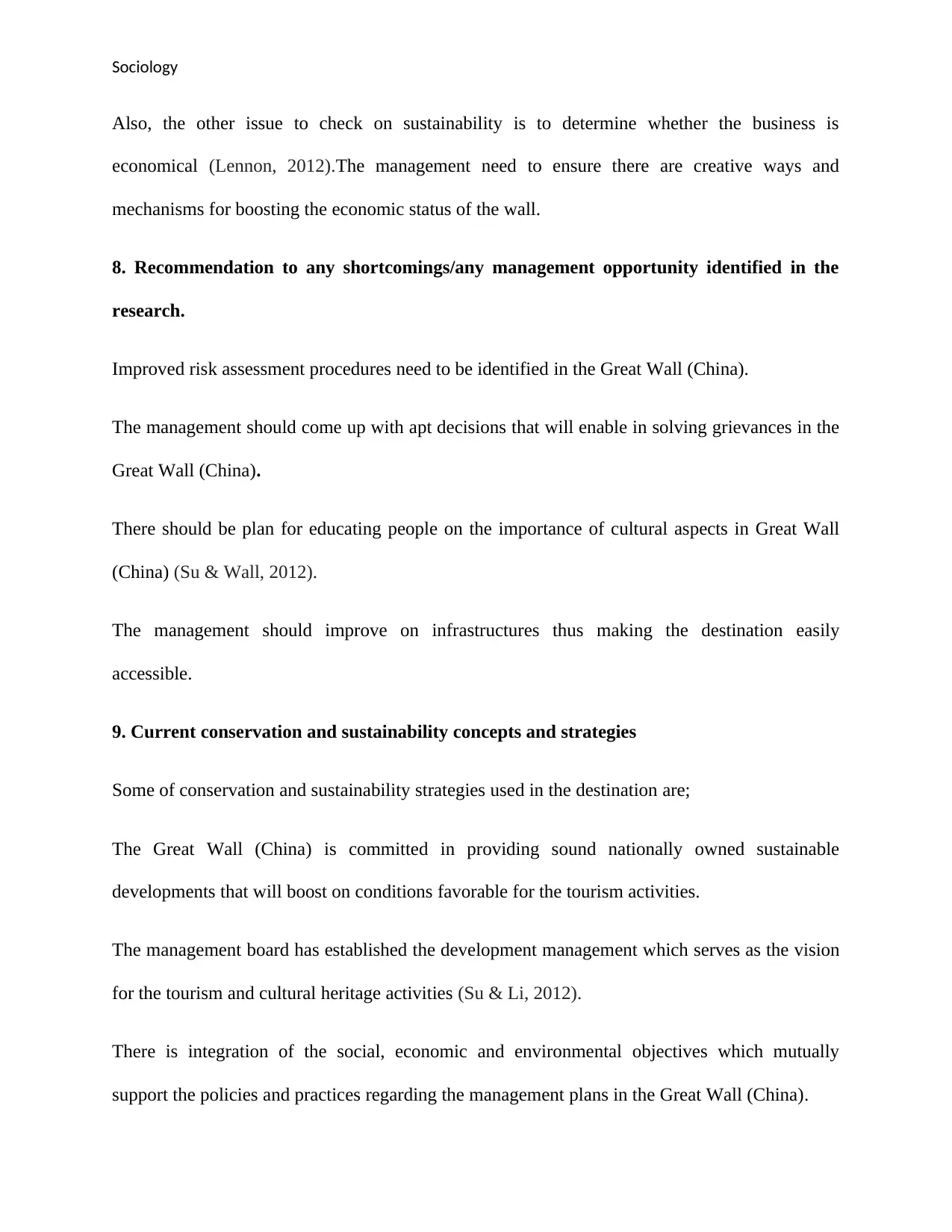
Sociology
Also, the other issue to check on sustainability is to determine whether the business is
economical (Lennon, 2012).The management need to ensure there are creative ways and
mechanisms for boosting the economic status of the wall.
8. Recommendation to any shortcomings/any management opportunity identified in the
research.
Improved risk assessment procedures need to be identified in the Great Wall (China).
The management should come up with apt decisions that will enable in solving grievances in the
Great Wall (China).
There should be plan for educating people on the importance of cultural aspects in Great Wall
(China) (Su & Wall, 2012).
The management should improve on infrastructures thus making the destination easily
accessible.
9. Current conservation and sustainability concepts and strategies
Some of conservation and sustainability strategies used in the destination are;
The Great Wall (China) is committed in providing sound nationally owned sustainable
developments that will boost on conditions favorable for the tourism activities.
The management board has established the development management which serves as the vision
for the tourism and cultural heritage activities (Su & Li, 2012).
There is integration of the social, economic and environmental objectives which mutually
support the policies and practices regarding the management plans in the Great Wall (China).
Also, the other issue to check on sustainability is to determine whether the business is
economical (Lennon, 2012).The management need to ensure there are creative ways and
mechanisms for boosting the economic status of the wall.
8. Recommendation to any shortcomings/any management opportunity identified in the
research.
Improved risk assessment procedures need to be identified in the Great Wall (China).
The management should come up with apt decisions that will enable in solving grievances in the
Great Wall (China).
There should be plan for educating people on the importance of cultural aspects in Great Wall
(China) (Su & Wall, 2012).
The management should improve on infrastructures thus making the destination easily
accessible.
9. Current conservation and sustainability concepts and strategies
Some of conservation and sustainability strategies used in the destination are;
The Great Wall (China) is committed in providing sound nationally owned sustainable
developments that will boost on conditions favorable for the tourism activities.
The management board has established the development management which serves as the vision
for the tourism and cultural heritage activities (Su & Li, 2012).
There is integration of the social, economic and environmental objectives which mutually
support the policies and practices regarding the management plans in the Great Wall (China).
Paraphrase This Document
Need a fresh take? Get an instant paraphrase of this document with our AI Paraphraser
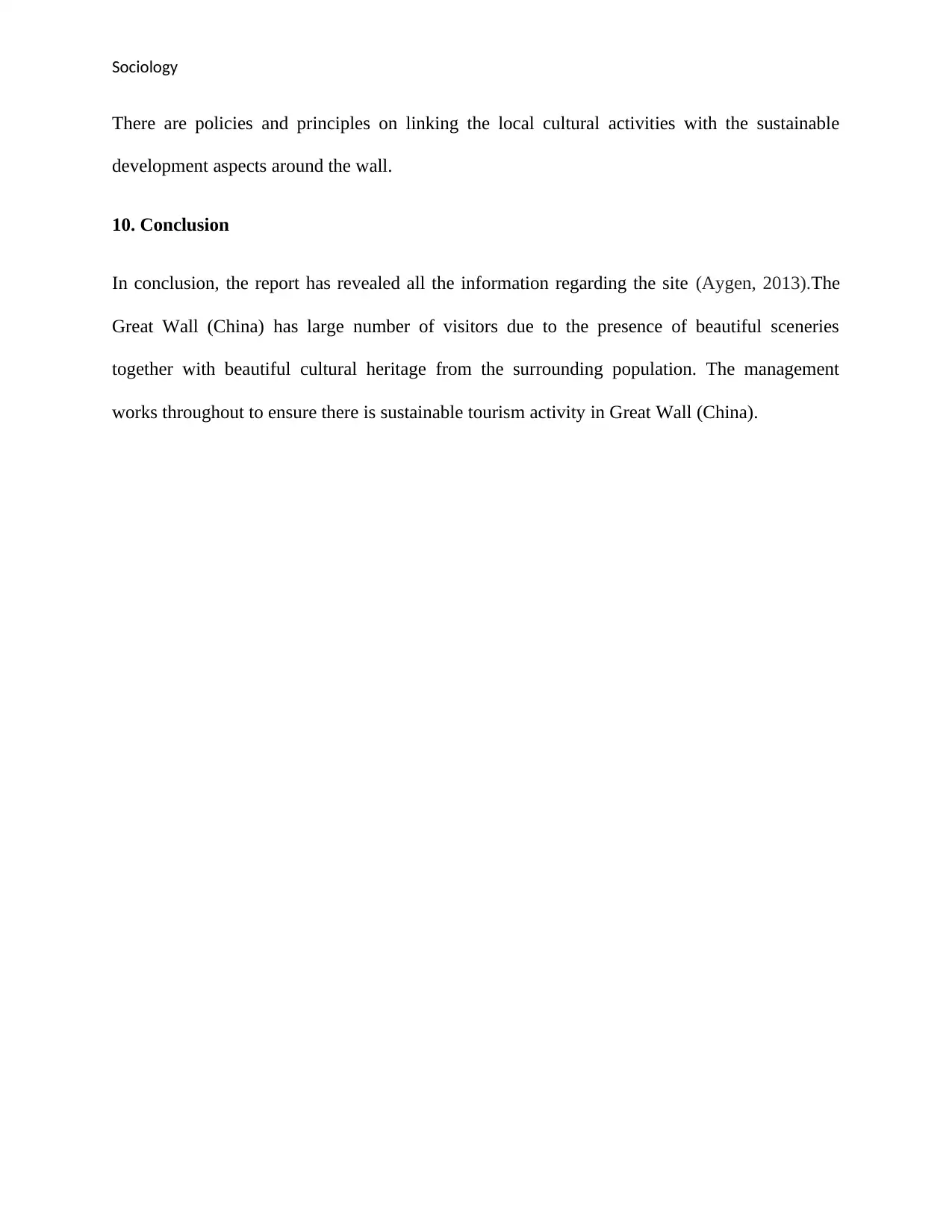
Sociology
There are policies and principles on linking the local cultural activities with the sustainable
development aspects around the wall.
10. Conclusion
In conclusion, the report has revealed all the information regarding the site (Aygen, 2013).The
Great Wall (China) has large number of visitors due to the presence of beautiful sceneries
together with beautiful cultural heritage from the surrounding population. The management
works throughout to ensure there is sustainable tourism activity in Great Wall (China).
There are policies and principles on linking the local cultural activities with the sustainable
development aspects around the wall.
10. Conclusion
In conclusion, the report has revealed all the information regarding the site (Aygen, 2013).The
Great Wall (China) has large number of visitors due to the presence of beautiful sceneries
together with beautiful cultural heritage from the surrounding population. The management
works throughout to ensure there is sustainable tourism activity in Great Wall (China).
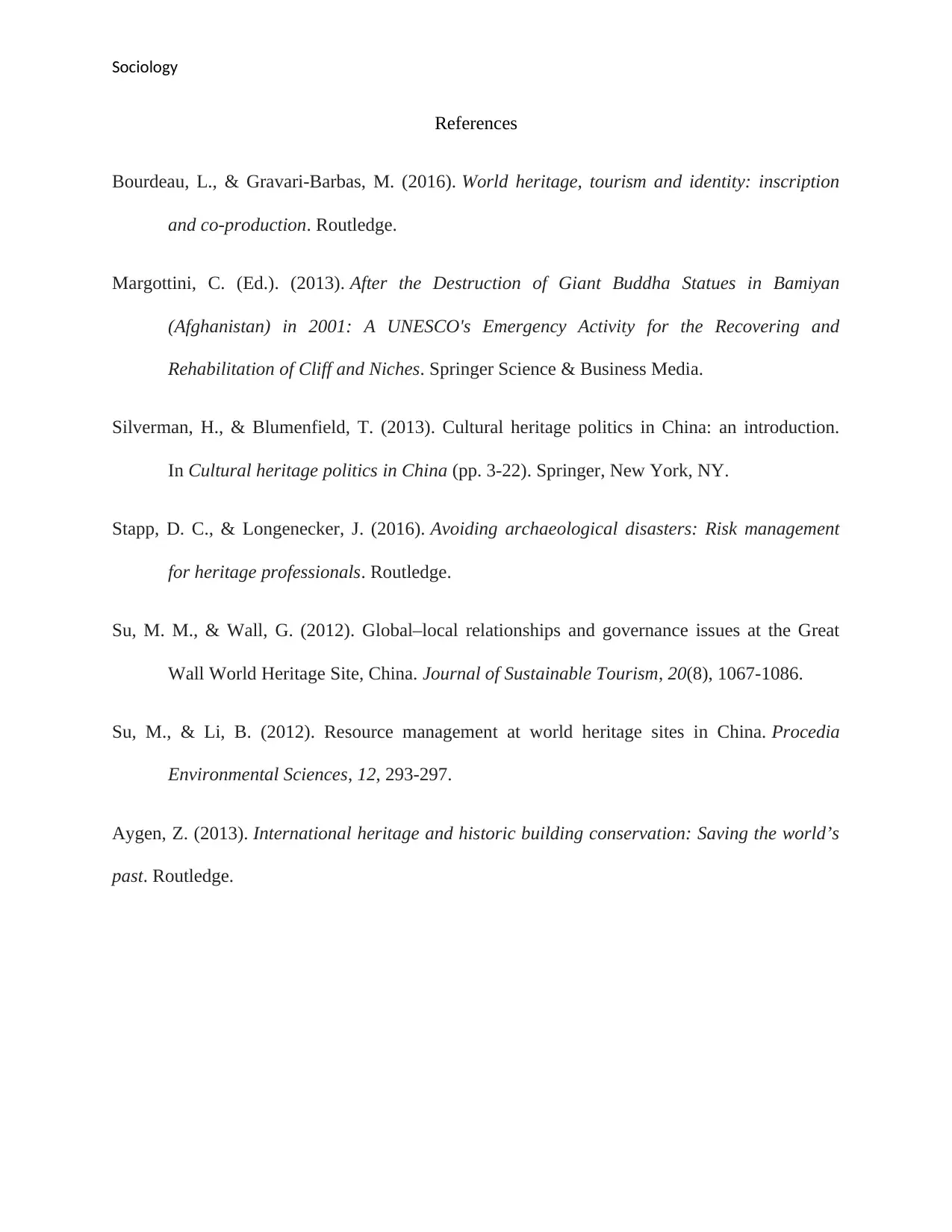
Sociology
References
Bourdeau, L., & Gravari-Barbas, M. (2016). World heritage, tourism and identity: inscription
and co-production. Routledge.
Margottini, C. (Ed.). (2013). After the Destruction of Giant Buddha Statues in Bamiyan
(Afghanistan) in 2001: A UNESCO's Emergency Activity for the Recovering and
Rehabilitation of Cliff and Niches. Springer Science & Business Media.
Silverman, H., & Blumenfield, T. (2013). Cultural heritage politics in China: an introduction.
In Cultural heritage politics in China (pp. 3-22). Springer, New York, NY.
Stapp, D. C., & Longenecker, J. (2016). Avoiding archaeological disasters: Risk management
for heritage professionals. Routledge.
Su, M. M., & Wall, G. (2012). Global–local relationships and governance issues at the Great
Wall World Heritage Site, China. Journal of Sustainable Tourism, 20(8), 1067-1086.
Su, M., & Li, B. (2012). Resource management at world heritage sites in China. Procedia
Environmental Sciences, 12, 293-297.
Aygen, Z. (2013). International heritage and historic building conservation: Saving the world’s
past. Routledge.
References
Bourdeau, L., & Gravari-Barbas, M. (2016). World heritage, tourism and identity: inscription
and co-production. Routledge.
Margottini, C. (Ed.). (2013). After the Destruction of Giant Buddha Statues in Bamiyan
(Afghanistan) in 2001: A UNESCO's Emergency Activity for the Recovering and
Rehabilitation of Cliff and Niches. Springer Science & Business Media.
Silverman, H., & Blumenfield, T. (2013). Cultural heritage politics in China: an introduction.
In Cultural heritage politics in China (pp. 3-22). Springer, New York, NY.
Stapp, D. C., & Longenecker, J. (2016). Avoiding archaeological disasters: Risk management
for heritage professionals. Routledge.
Su, M. M., & Wall, G. (2012). Global–local relationships and governance issues at the Great
Wall World Heritage Site, China. Journal of Sustainable Tourism, 20(8), 1067-1086.
Su, M., & Li, B. (2012). Resource management at world heritage sites in China. Procedia
Environmental Sciences, 12, 293-297.
Aygen, Z. (2013). International heritage and historic building conservation: Saving the world’s
past. Routledge.
1 out of 9
Related Documents
Your All-in-One AI-Powered Toolkit for Academic Success.
+13062052269
info@desklib.com
Available 24*7 on WhatsApp / Email
![[object Object]](/_next/static/media/star-bottom.7253800d.svg)
Unlock your academic potential
© 2024 | Zucol Services PVT LTD | All rights reserved.


